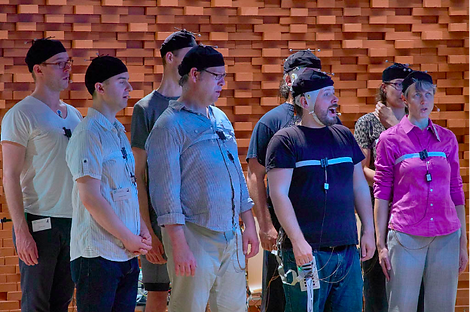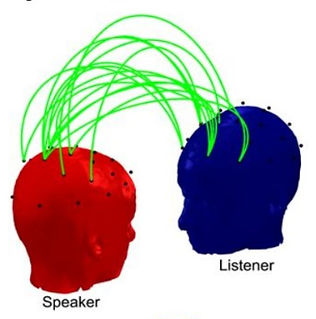Visualizing Hyperscanning
Neuroscientists have found that most times our brain waves are "out of phase" with one another. But when people interact or do something with one another, our brain waves tend to become more "in phase" with each other, i.e. synchronized. That is, the peaks and valleys of our brain waves begin to go up and down in alignment. Studies have also shown that when we feel emotionally connected to one another, our brains become even more deeply synchronized. When we feel connected with one another, our brains are becoming measurably more coherent. Here are some diagrams and images that show these findings.


Waves that are In Phase & Out of Phase
Here is a diagram of sine waves that are "out of phase" and "in phase," i.e. "synchronized" or "coherent."
A Hyperscanning Setup
Hyperscanning studies look at several people's brains and physiologies simultaneously. The caps contain several EEG leads, the devices on their chests measure breathing and heartrate. In this picture, physiology (heart rate and breathing), motion capture and EEG signals are being recorded from eight singers simultaneously. © Max Planck Institute for Empirical Aesthetics. Creative commons licenses/by/2.0. http://creativecommons.org/licenses/by/2.0.


Speakers & Listeners
While neuroscientists have found that when we encounter the same sensory information, our brains tend to synchronize. Looking at the brains of pairs of speakers and listeners, Perez identified just such a set of connections. But he also found robust synchronization that was not connected to the sensory input. This diagram shows the connections in the alpha and beta bands that “seemed to emerge directly from the mutual interaction of the dyad, without being mediated by the physical properties of speech. [This is a] 'pure' instance of brain-to-brain entrainment.” The green lines mark the brain-to-brain coherence that can NOT be explained by the mediating role of speech. Pérez et al. (2017). Brain-to-brain entrainment: EEG interbrain synchronization while speaking and listening. Alejandro Pérez, et al. Scientific Reports, 2017, 7(1):4190, fig. 4. Creative commons license, https://creativecommons.org/licenses/by/4.0/.
Hyperscanning Video
Here is a clear video introduction to the hyperscanning process by Suzanne Dikker

Real Time Interbrain Synchrony
This diagram shows the EEG connections between two guitarists playing a duet. When the two musicians coordinate their actions, neuroscientists have found neural, physiological, and behavioral synchronicities. The colored lines indicate synchrony between electrode pairs of the two guitarists, showing significant interbrain synchronization. The colors indicate the strength of the synchronization ranging from 0.0 to 1.0. © Picture taken from Lindenberger, U., Li, S.C., Gruber, W. et al. Brains swinging in concert: cortical phase synchronization while playing guitar. BMC Neurosci 10, 22 (2009). Creative commons licenses/by/2.0. http://creativecommons.org/licenses/by/2.0.
The More Satisfying the Kiss,the Stronger Our Brains' Synchronicity
This chart plots the "kissing satisfaction" against two measures of the strength of inter-brain coherence between couples having a "romantic" kiss (RK) and couples who were asked to do arithmatic while they kissed (K-SA). Note that as the kissing satisfaction increases, towards the right, the line in each chart slops upwards. This suggests that the interbrain coherence increases when couples have a more satifying kiss: the more a couple reports enjoying a kiss, the stronger the couple’s inter-brain synchronicities: our feelings, both good and bad, correlate with our interbrain connections. Chart taken from Müller, V. and Lindenberger, U. (2014). "Hyper-brain networks support romantic kissing in humans." PloS ONE 9(11): e112080,
fig. 5. Creative commons license (CC/BY).

